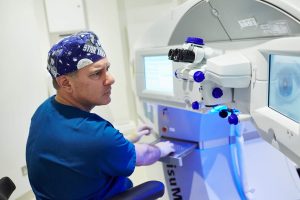Does Laser Eye Surgery Technology Correlate with Costs?

Over the last few decades, Laser Eye Surgery has advanced almost beyond measure. This is largely thanks to the new and innovative technologies that are becoming increasingly available across the field. These new technologies have improved our ability to treat higher prescriptions and helped us to make the procedure less invasive than ever before – but does all this come with a cost?
The Cost of Laser Eye Surgery Technology
Back in 1948 when Spanish ophthalmologist Jose Barraquer Moner first came up with the theory behind Laser Eye Surgery, the technology available to him was much less advanced than it is today. His early iteration of the procedure involved manually removing the cornea with an oscillating blade and reattaching it with sutures.
Thankfully, refractive surgery is much less grizzly today – thanks to the introduction of laser technology. Of course, developing this technology hasn’t been cheap.
The latest equipment used in Laser Eye Surgery treatment today utilises incredibly advanced technology. It is the result of the greatest minds in the field working together to consistently improve the treatments – and the results we are able to achieve. Funding these advancements is only possible because of the millions of people to date who have undergone the procedure. That is to say, advancing the technology and techniques of course improves patient outcomes, but it also comes at a cost.
Generally speaking, patients can expect Laser Eye Surgery procedures that use newer technologies to come with a higher price tag. For example, it will probably cost more to have a ReLEx SMILE procedure than LASEK/PRK. So, is it really worth it?
The Evolution of Laser Eye Surgery Technology
Refractive Surgery has advanced beyond almost all recognition from its origins almost eight decades ago. Laser Eye Surgery itself has even improved immensely since the first procedure was conducted in 1989. Since then, increasingly innovative developments became embedded in the story of Laser Eye Surgery. Even the latest technology in use today is likely just a stepping stone in the evolution of Laser Eye Surgery.
Our very own founder and surgeon, Professor Dan Reinstein, has played a significant role in this ongoing development. He has contributed to the pioneering development of the MEL 80 laser – the world’s most accurate laser (according to United States FDA tests) and the Artemis Insight 100 scanner – the world’s most accurate corneal scanner. Prof Reinstein also developed PRESBYOND® Laser Blended Vision – a solution to presbyopia that we have offered to patients since 2004.
But how have these developments benefitted patients?
Over the decades, improvements have had a significant effect on the safety and success of Laser Eye Surgery procedures. Clinics with access to the most up-to-date technology are usually able to treat patients with higher prescriptions. Advances in Laser Eye Surgery technology have also helped to significantly improve recovery times.
These benefits can be observed in ReLEx SMILE, an innovative procedure that is much less invasive than traditional surface procedures such as PRK and LASEK. The technology used in SMILE allows the surgeon to reshape the cornea through a tiny hole in the surface of the eye. This removes the need to remove epithelial tissue, reducing the time needed for the eye to heal.
Many patients who would previously have been unsuitable for Laser Eye Surgery – for example, due to having thinner corneas or dry eyes – are now eligible for treatment. In fact, at London Vision Clinic, we are now able to treat around 98% of the patients we see. This is thanks to a combination of our access to world-renowned surgeons and the most up-to-date Laser Eye Surgery technology.
How do higher costs benefit the Laser Eye Surgery technology of the future?
The benefits of modern Laser Eye Surgery highlighted above would not have been possible without the continuous development of new and innovative technologies. But there is still room to improve treatment and outcomes even further.
The costs of Laser Eye Surgery help us to achieve this. These costs usually go towards:
- Purchase and maintenance of laser and diagnostic devices;
- Royalty fees and the cost of development of the machines;
- Facility fees and equipment costs such as gowns, masks, gloves and other items for keeping the operation sterile;
- On-going research and further development of laser technologies;
- Employing qualified staff to work with patients on an administrative level, perform examinations both pre- and post-operatively, and perform diagnostic scans and surgery.
At London Vision Clinic, we have our own research team who continuously analyse our results for ways to further refine our Laser Eye Surgery techniques to achieve even better results.
If you’d like to learn more about the technology used at London Vision Clinic, get in touch with one of our friendly clinic coordinators today. Alternatively, Book a Consultation to start your journey to glasses-free clear vision.


